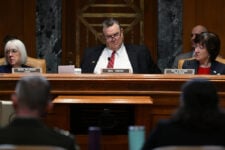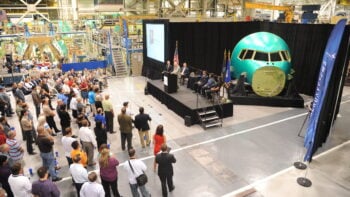
Vice President Kamala Harris chairs the National Space Council, which led the interagency process to developing the new commercial space regulatory policy. (Photo by Drew Angerer/Getty Images)
WASHINGTON — The White House today released its long-awaited framework for establishing a future regulatory scheme for activities in space that currently fall outside federal agency licensing authorities, such as on-orbit refueling and repair capabilities increasingly coveted by the the Defense Department — with a clear focus on supporting US industry in expanding the future space economy.
At the same time, the document stresses the Biden administration’s commitment to protecting the “sustainability” of the space environment, including a provision for a biennial review of orbital debris mitigation requirements.
The new United States Novel Space Activities Authorization and Supervision Framework [PDF] was announced by Vice President Kamala Harris at the administration’s third meeting of the National Space Council, which was responsible for shepherding its interagency development process.
“This, I believe, is one of the most significant steps we have taken to shape the future of the commercial space industry. President Biden and I are committed to establishing rules for commercial space activities that are strong enough to promote the safe and predictable, use of space, but flexible enough to ensure that we do not stifle innovation,” Harris said.
Citing the rapid pace of private sector space innovation, powered by private sector capital and US government funding, the document stresses that pushing the boundaries of the final frontier is firmly in US national interests.
“The U.S. Government is partnering with the commercial space industry to advance national objectives including space exploration, national security, combating the climate crisis, and international partnerships, including building commercial space stations, in-space assembly and manufacturing, extracting and using resources on the Moon, addressing the hazard of space debris, and fueling stations in orbit,” according to the White House press release announcing the new framework.
While it doesn’t directly reference the fact, the Space Force is counting on commercial industry to lead the way in a number of these new technologies that would underpin the service’s goal of dynamic space operations, the service’s new concept for offensive or defense operations in space based on highly maneuverable spacecraft and rapid response to on-orbit threats.
“DoD believes the new framework for novel commercial space activities will enable even more fostering of a competitive environment that attracts new investment, encourages innovation and novel space activities, and benefits the economy and national security,” Deputy Defense Secretary Kathleen Hicks told the National Space Council meeting.
A White House fact sheet explains that the framework is a policy companion to the draft legislation presented to Congress last month that would split regulatory authority for new types of commercial space activities between the Departments of Commerce and Transportation.
Currently, the Commerce Department (DoC), via the National Oceanic and Atmospheric Administration, regulates commercial remote sensing systems; the Transportation Department (DoT), via the Federal Aviation Administration (FAA), regulates commercial launch and reentry. Meanwhile, the semi-independent Federal Communications Commission (FCC) regulates use of the electromagnetic spectrum, including by satellites.
Easing Industry Into The Regulatory Fold
The White House’s draft bill faced initial hostility from a swath of commercial space firms, many of which are backed by venture capital and in general hostile toward all but minimal regulation — as well as skepticism from lawmakers on both sides of Capital Hill who oversee commercial space issues. The new framework’s focus on cutting red tape, however, could go some ways to overcoming those concerns.
For example, the policy package provides clear assurances for fast-track license reviews and transparent processes for resolving differences among agencies about whether approval should be granted to give companies the ability to help mitigate concerns. It further establishes a “Private Sector Space Activities Interagency Steering Group to formulate longer term policy and best practices to inform the work of regulatory agencies.”
The framework elaborates:
To the greatest extent feasible, the Secretaries of Commerce and Transportation should minimize burdens on industry and U.S. Government entities by aligning oversight processes for private space sector novel activities, including strict timelines for applications and interagency reviews, with a transparent elevation process to adjudicate disagreements, and should harmonize the timing of, and language in, legislative proposals and respective Administrative Procedure Act rulemakings.
Further, it stresses that new “regulations and other rules should start with a presumption of an expedited review for approval,” which “requires that a denial or request for modification of a licensing request must be based on an articulable national interest and should be as narrowly construed as feasible.”
Keeping Space Safe
While promising a streamlined process for new licenses, the regulatory package does not back away from the Biden administration’s previous commitments to space safety — an area in which US officials have been active on the international stage in promoting voluntary norms toward those goals.
“This oversight regime will balance economic competitiveness together with safety, security, sustainability, and responsibility,” the document says. “Consideration of the long-term sustainability of space activities across the life cycle of space systems is critical to ensure that the outer space environment remains suitable for exploration and use by current and future generations.”
The administration is convinced of “the need to establish and strengthen international rules and norms for the peaceful and responsible use of space, common understandings of what is permissible and what is not,” Harris said.
“We intend that these domestic rules will serve as a model for global action,” she added.
The framework says that when developing licensing procedures, the Commerce and Transportation secretaries “should consider whether to require measures to protect the sustainable use of outer space in their regulations, to include the mitigation and remediation of orbital debris and consideration of impacts to the space operational environment.”
In addition, it mandates that the NASA, “in coordination with” the department of Commerce, Defense, State, and Transportation, and the Office of the Director of National Intelligence, as well as “in consultation with” the FCC, “should evaluate the need to update the ODMSP every two years and provide a recommendation to the National Space Council.
The ODMSP, or Orbital Debris Mitigation Standard Practices, sets the minimum standards that federal agencies should impose on commercial space operators for ensuring that they don’t create too much hazardous space junk. Those rules were last updated in 2019, but NASA has been leading a study since last July on whether they need to be tightened to deal with the skyrocketing numbers of satellites being launched — in particular into the already overcrowded low Earth orbit region roughly between 100 and 2,000 kilometers above sea level.
Army leader dismisses House proposal for drone branch creation
“Operating and defending against the drone threat is something that will be experienced by, you know, all formations at multiple echelons,” said Army Undersecretary Gabe Camarillo.


























